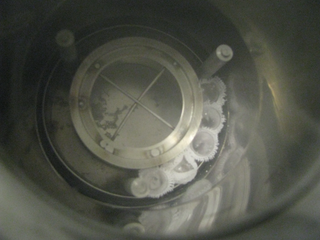If life exists on the icy ocean moons of Enceladus and Europa, traces of detectable molecules could survive just beneath their frozen surfaces.
Scientists have long hypothesized that Enceladus, one of Saturn’s 146 known moons, and Europa, one of Jupiter’s four large Galilean moons among its 95 moons, could harbor vast oceans of liquid water that support life. If so, then complex organic molecules like amino acids and nucleic acids, the building blocks of life as we know it, could serve as “biosignatures” of life on these planets.
The problem, however, is that Europa and Enceladus are bombarded by powerful solar radiation that could destroy the complex organic molecules on their surfaces. But new research offers some hope, suggesting that these biosignatures could indeed survive if preserved in the moons’ icy shells. And if that’s true, these molecules could be so close to the surface that future robotic landers could dig them out. In fact, on Enceladus, this digging might not even be necessary; the biosignature molecules could survive in shallower ice than on Europa.
“Based on our experience, the ‘safe’ sampling depth for amino acids on Europa is about 20 centimeters at high latitudes in the trailing hemisphere, the hemisphere opposite the direction of Europa’s motion around Jupiter, in the area where the surface has not been heavily disturbed by meteorite impacts,” Alexander Pavlov, lead scientist at NASA’s Goddard Space Flight Center in Greenbelt, Maryland, said in a statement. “Subsurface sampling is not necessary for amino acid detection on Enceladus – these molecules will survive radiolysis, or radiation degradation, anywhere on Enceladus’ surface within a tenth of an inch (less than a few millimeters) of the surface.”
Related: If alien life exists on Europa, we could find it in hydrothermal vents
The spectacular plumes erupting through Enceladus’ icy shell could also mean that orbiting robotic missions will be able to extract these biosignature molecules from around the Saturnian moon without needing to visit the surface.

Life would be deep on the icy moons
Although Europa and Enceladus are often cited as two of the most likely planets to support life elsewhere in the solar system, it is highly unlikely that life would develop on the surface of these moons. This is because not only are they virtually atmosphereless and icy, but they are also surrounded by energetic particles and radiation from the sun and cosmic rays from powerful events such as supernovae beyond the solar system.
Yet Europa and Enceladus are thought to harbor oceans of liquid water beneath their thick, ice-shell-like surfaces. These oceans would be protected from these particles and warmed by geothermal heat generated by the gravitational pull that the moons’ parent planets and twin moons exert on them.
This would mean that as long as these underground oceans have the right chemistry and an energy source, life could live there.
To investigate this question, Pavlov and his colleagues tested amino acids undergoing radiolysis. Although amino acids can be created by living things or by nonbiological processes, their discovery on Europa or Enceladus would be a potential sign of life, simply because they are important to life on Earth as a key component in building proteins. The amino acids could be produced in the deep oceans of these moons, through geyser activity, or by the swirling motion of the icy outer shells themselves.

The team took samples of amino acids, sealed them in airtight vials, and cooled them to about minus 196 degrees Celsius. The researchers then bombarded the amino acids with high-energy light called gamma rays at different intensities to test the molecules’ survival abilities.
The researchers also tested the ability of amino acids to survive in dead bacteria trapped in the ice of Europa and Enceladus, and studied the effects that mixing with meteorite material might have on their survival.
By taking into account the age of the ice on Europa and Enceladus, as well as the radiation environments around the two moons, the team was able to calculate the drilling depth and locations where 10% of the amino acids would survive radiolytic destruction.
Experiments of this type have been conducted before, but this particular test provided two firsts.
This was the first time researchers had considered applying lower doses of radiation to these molecules, which do not completely destroy the amino acids, and the team reasoned that the damaged or degraded molecules could still serve as biomarkers. It was also the first time such a test considered the survival of the amino acids in conjunction with meteorite dust.
The team found that amino acids degraded more quickly when mixed with silica, such as those found in meteorite dust. However, amino acids from dead microbacteria degraded at a slower rate than average. This may be because the bacterial cell material protects the amino acids from reactive compounds created by the radiation bombardment that would otherwise speed up their degradation.
“The low rates of amino acid destruction in biological samples under surface conditions similar to those of Europa and Enceladus reinforce the interest in future life detection measurements by the Europa and Enceladus landing missions,” Pavlov said. “Our results indicate that the decay rates of potential organic biomolecules in the silica-rich regions of Europa and Enceladus are higher than in pure ice, and therefore possible future missions to Europa and Enceladus should be cautious in sampling silica-rich sites on both icy moons.”
The team’s paper was published Thursday (July 18) in the journal Astrobiology.